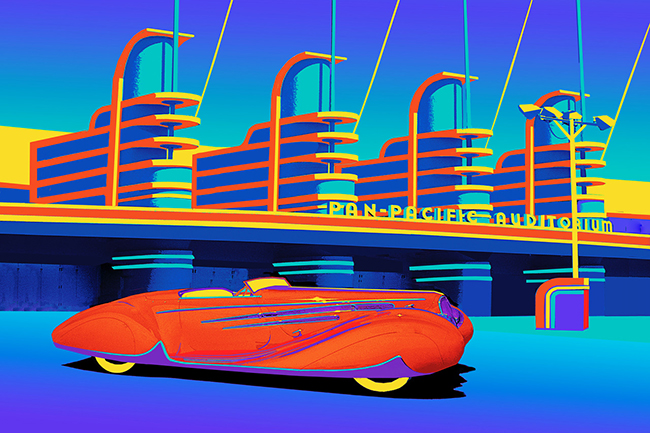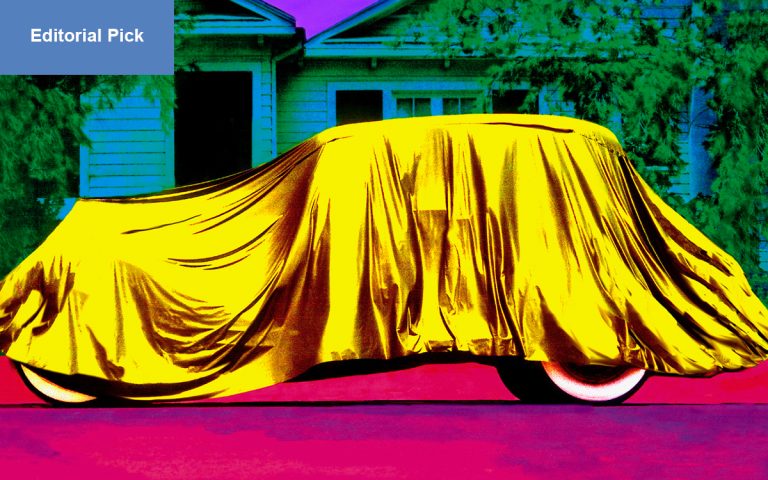Jane Gottlieb is an artist who has built her life around the language of color. Born and based in Los Angeles, she began with painting, then shifted toward photography, only to circle back by bringing the painter’s hand into her photographic work. Over three decades ago, she entered a new phase of creativity: hand-painting Cibachrome prints, a medium that allowed her to merge photography with her love of bold, saturated hues. Her work doesn’t sit neatly in one category—it carries the discipline of painting, the immediacy of photography, and the vision of someone unwilling to stop at the surface. Through these explorations, she found her signature style: radiant images that elevate the everyday into something surreal, playful, and unforgettable. Gottlieb’s practice is both deeply personal and outwardly celebratory, a lifelong exploration of how shape, form, and especially color can reshape how we see the world.

The Work: Deco Delight and the Joy Rides Series
It is not easy to pick one image that defines Jane Gottlieb’s art, but Deco Delight stands out as a favorite. Part of her Joy Rides series, it captures the essence of what she has always done best—bringing forgotten places and overlooked objects back into the light through color, transformation, and imagination.
The work is built from two photographs. One is of the Pan Pacific Auditorium, an art deco landmark in Los Angeles. Built in 1935, the building once symbolized the optimism and glamour of its era, with sweeping curves and stylized towers. But after decades of neglect, it crumbled. In 1989, fire destroyed what was left, and the site was eventually cleared. It is one of the many architectural losses of Los Angeles, a city where history is often sacrificed to new construction. Gottlieb, however, holds onto it—not as a ruin, but as an icon.
The second photograph in Deco Delight is of a Deco Delahaye automobile, taken at the Petersen Automotive Museum years ago. The car, with its streamlined design and sculptural bodywork, mirrors the same period style as the auditorium. By pairing these two images, Gottlieb creates a conversation between architecture and automobile, both products of an era that celebrated ornament, luxury, and movement.
But the photographs themselves were only the starting point. Gottlieb then painted and digitally enhanced the images, infusing them with her signature palette—intense, otherworldly colors that feel almost electric. What was once black-and-white memory or faded archive becomes vibrant and alive. It is not a restoration in the traditional sense; she is not trying to replicate the way these objects once looked. Instead, she reimagines them, elevating them into a dream version of themselves. The building and the car, both relics of art deco design, become part of a surreal stage where history is not mourned but celebrated.
The Joy Rides series to which Deco Delight belongs had a wide reach. It was exhibited across the United States and Europe, with stops in Los Angeles, Aspen, Rome, and London. The Petersen Automotive Museum itself showcased 36 of the works for three years, a fitting home for images that pair architecture with automobiles, fantasy with history.
At its heart, Deco Delight and the wider Joy Rides series carry a kind of playful nostalgia. Gottlieb is not documenting history in a conventional way, nor is she simply painting over it. Instead, she is constructing what might be called “alternate histories”—visions of what these spaces and objects could look like if they were never abandoned, if they were charged instead with the vibrancy of her own imagination. The works become tributes, yes, but also statements about resilience. Even when the Pan Pacific Auditorium no longer exists, in Gottlieb’s world it still shines, dressed in color that refuses to fade.
That approach defines much of Gottlieb’s practice. She begins with something recognizable—landmarks, cars, architecture—and then reframes it through saturation and hue until it becomes dreamlike. The technique bridges painting and photography but resists being pinned down by either. In that sense, her art embodies a kind of freedom: the ability to move between mediums, to resurrect the past without being bound by accuracy, and to invite viewers into a world that feels both familiar and strange.
Deco Delight is more than just a photograph of a building and a car. It is a visual reminder of how art can preserve what time and circumstance have taken away. It speaks to Gottlieb’s lifelong relationship with color and her refusal to let memory sit quietly in the archive. Instead, she insists on bringing it forward, bold and unapologetic, so it can continue to live.

